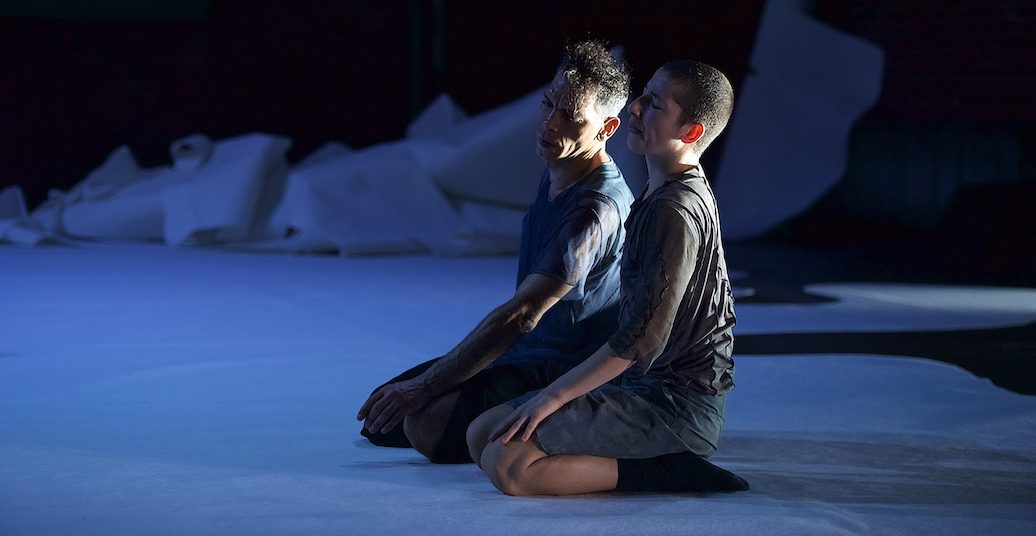Sergiu Matis’s “DRANG”, which premiered at radialsystem on 17 February 2022 as one of the featured performances of Tanzfabrik’s Open Spaces festival, keeps its emotional distance while still offering to suck audiences into its world by playing with size and scale.
‘THERE IS NO PLANET B’ screams a hand painted banner hanging from a tall fence in Kreuzberg that I often walk past with my dog. The message is meant for me, and you, and you, and you. For every passerby. I know what the banner wants from me even if it doesn’t always receive it: “Feel something. Wake up. Scream with me.”
“THERE IS NO PLANET B,” sang Sergiu Matis partway through “DRANG”, in a trembling falsetto accompanied by Ana María Fonseca Núñez on the harpsichord. I chuckled at this moment the night I saw the performance, but softly, not sure how silly it was intended to be.
It was a brief, unusual breath of relative stillness in the work, most of which felt to me like a continuous electrified field of movement made up of interrupted, flickering gestures. The bodies of performers Eli Cohen, Orlando Rodriguez, Diletta Sperman, and choreographer Matis seemed animated from within, moved by shapes taken from a legacy of classical dance that they appeared unable to stifle. A courtly curve in an arm caught my eye, then disappeared again as if erased by the static of a bad TV connection. A balletic toe popped into view and then immediately out again. The dancers seemed endlessly surprised and unsettled by the forms that bubbled up out of their bodies. Yet the edges of their movements were sharply defined, precise, choreographed. This gave me the unshakable feeling that they were performing their own reactions for the purpose of telling a story about being products of history and about the panic induced by being unable to exit that history, rather than experiencing the panic anew as I watched.
“DRANG” is part of a series of performances by Matis that explore the relationship between nature and society. The title took me directly to the Sturm und Drang movement, which the description of the performance underscores by references to proto-Romantic ideas and aesthetics. For a brief, explosive period in the German-speaking states in the second half of the 1700s, Sturm und Drang (generally translated as ‘Storm and Stress’) also addressed nature and society when the cross-genre artistic works belonging to it lashed out against the stifling rationality of the Enlightenment and aimed to stir intense emotion in their audiences.
You could say that a lot of art and activism dealing with the climate crisis today takes a resonant approach, in the sense that (as with the ‘THERE IS NO PLANET B’ banner) there seems to be an intention to provoke feelings such as horror, panic, rage, and grief, and that these are meant to provide a vantage point from which to question and challenge the big human economic and social systems that are leading to environmental collapse. However, even though Matis’s performance is full of intense emotion, watching “DRANG” didn’t take me on a Sturm und Drang-like emotional journey of my own. It was more like watching someone else going through such a journey through fear or grief and then into hope.
Much of “DRANG” gave me the sense of watching Whos scuttling around Whoville, quaveringly singing for help to an impassive sky. But, at the very end of the piece — after they stopped screaming in tones of horror “What is this place?,” after they stopped dreaming of blasting through space at the centre of fiery asteroids, after they blockaded the exit — a curious inversion happened. Instead of burning planets raining fire, the projection on the back wall of the radialsystem space showed slender-stalked orange mushrooms, towering over me as if I were the size of an ant. The performers fit together poles draped with holey beige cloth and constructed a creature two or three times their own height that they moved in a swaying dance over the audience, a creature that reminded me at some moments of a mantis, and at others of a slug. I’m still unsure whether the aim of the performance was for me to feel the full range of emotions the dancers represented over its 90 minutes, but I did experience a change in vantage point — my sense of looking down through a microscope at something helpless and trapped was replaced by the sense of gazing up at something unfolding.
“DRANG” by Sergiu Matis premiered on 17 February 2022 at radialsystem in the frame of The Last Open Spaces? Festival by Tanzfabrik Berlin. The festival is still running until 28 February 2022, find the program and ticket info at tanzfabrik-berlin.de.




